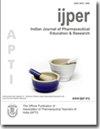Multiparticulate Floating Beads an Aid to Enhance Therapeutic Efficacy of Rabeprazole
IF 0.8
4区 医学
Q3 EDUCATION, SCIENTIFIC DISCIPLINES
Indian Journal of Pharmaceutical Education and Research
Pub Date : 2023-08-23
DOI:10.5530/ijper.57.3s.62
引用次数: 0
Abstract
Background: Rabeprazole sodium is a newer generation anti-ulcer drug with short half-life and low bioavailability. Present research work is an attempt to design novel floating beads of Rabeprazole sodium in multiparticulate dosage form to increase residence time and modulate its release behavior for stomach-specific delivery. Materials and Methods: In this present study, Rabeprazole sodium beads were formulated by ionotropic gelation method and effect of variation in sodium alginate and gellan gum concentrations alone and in combination on release properties was examined. Results: Formulated beads were analyzed for particle size, density, entrapment efficiency, swelling index, in vitro buoyancy properties, surface topography, in vitro drug release and release kinetics study. The percentage content and entrapment efficiency of Rabeprazole sodium in beads ranged from 77.06±3.612 to 92.88±5.723 and 57±1.543 to 89±1.089 respectively. In vitro drug release of Rabeprazole sodium from the beads at the end of 12 hr ranged from 69.373% to 97.0142%. The release behavior was best fitted in Korsemeyer-Peppas equation. F9 was optimized depending on entrapment efficiency, in vitro buoyancy properties and in vitro drug release. Modified formulation F9 was also subjected to a series of tests. mucoadhesive study , in vivo X-ray imaging in rabbits and stability study. Conclusion: These studies revealed that beads exihibited 84% mucoadhesion, floating up to 12 hr as well as stability at 25±2°C. Hence Floating bead formulation of Rabeprazole sodium will be a promising drug delivery system to improve drug residence time and patient compliance.多关节漂浮珠辅助提高雷贝拉唑疗效
背景:雷贝拉唑钠是新一代抗溃疡药物,半衰期短,生物利用度低。目前的研究工作是试图设计新型多颗粒剂型的雷贝拉唑钠漂浮珠,以增加停留时间并调节其胃特异性递送的释放行为。材料和方法:本研究采用离子凝胶法制备雷贝拉唑钠微球,并考察了单独和联合使用海藻酸钠和结冷胶浓度的变化对释放性能的影响。结果:对处方珠粒径、密度、包封率、溶胀指数、体外浮力特性、表面形貌、体外药物释放和释放动力学研究进行了分析。雷贝拉唑钠在珠粒中的百分含量和包封率分别为77.06±3.612至92.88±5.723和57±1.543至89±1.089。雷贝拉唑钠在12小时结束时从珠粒中的体外释药率为69.373%~97.0142%。释放行为最符合Korsemeyer-Peppas方程。F9根据包埋效率、体外浮力特性和体外药物释放进行了优化。还对改性配方F9进行了一系列试验。粘膜粘附研究、兔体内X射线成像和稳定性研究。结论:这些研究表明,珠子能抑制84%的粘膜粘附,漂浮长达12小时,并在25±2°C下保持稳定。因此,雷贝拉唑钠浮珠制剂将是一种很有前途的药物递送系统,可以改善药物停留时间和患者依从性。
本文章由计算机程序翻译,如有差异,请以英文原文为准。
求助全文
约1分钟内获得全文
求助全文
来源期刊
CiteScore
1.40
自引率
0.00%
发文量
227
审稿时长
>12 weeks
期刊介绍:
The official journal of Association of Pharmaceutical Teachers of India (APTI) and is being published since 1967. IJPER, a quarterly publication devoted to publish reviews and research articles in pharmacy and the related disciplines of Pharmaceutical education. It mainly covers the articles of special interest, covering the areas of Pharmaceutical research, teaching and learning, laboratory innovations, education technology, curriculum design, examination reforms, training and other related issues. It encourages debates and discussions on the issues of vital importance to Pharmaceutical education and research. The goal of the journal is to provide the quality publications and publish most important research and review articles in the field of drug development and pharmaceutical education. It is circulated and referred by more than 6000 teachers, 40,000 students and over 1000 professionals working in Pharmaceutical industries, Regulatory departments, hospitals etc.

 求助内容:
求助内容: 应助结果提醒方式:
应助结果提醒方式:


